A Dynamic System to Control the Entry of Non-Authorized Visitors and Detect Superspreader Farms in Strongly Interconnected Systems
Abstract
Simple Summary
Abstract
1. Introduction
2. Materials and Methods
- Data collection system: Biorisk® External (Animal Data Analytics, SL; Segovia, Spain), a digital visitor control system, is a web application developed in .NET 5 framework by Animal Data Analytics SL in Segovia, Spain, that operates as Software as a Service (SaaS) in the cloud. Users can manually register visits via a cell phone using site-specific QR codes or leverage automatic registration utilizing GPS geolocation data from company or suppliers’ vehicles. Biosecurity rules and downtime movements between sites are customized based on the farm PRRS status [22]. If the farm status changes, the system updates each visitor accordingly with the associated risks, classifying them into three categories: authorized (A), not authorized with access (NAWA), and not authorized without access (NAWOA).
- Report generation: The application generates reports showing different metrics for the system’s routine management, including alerts, summaries, distributions, outbreak traceability, and its evolution. It can also include a timeline of visits and their category. All this information can be easily exported to perform the network analysis.
- Period: The system was implemented in two Spanish swine companies with a total of 142 sites and 30 vehicles (Table 1). Initially, a pilot project was conducted from September 2022 to July 2023, involving 30 sites and 4 vehicles. Thereafter, Biorisk® External was implemented in all sites of the two companies and visits to all sites were tracked up to December of 2023. Figure 1 shows a Biorisk® External map of the traced sites.
2.1. Statistical Analysis
2.1.1. Visit Evolution Timeline
2.1.2. Comparative Study
2.1.3. Network Study
- The vectors have only ones or zeros for their coordinates;
- If the vector has a 1 in the j-th coordinate, then the rest of the vectors in the basis have zeros in that coordinate.
3. Results
- Visit analysis
- Route Analysis
4. Discussion
5. Conclusions
Author Contributions
Funding
Institutional Review Board Statement
Informed Consent Statement
Data Availability Statement
Conflicts of Interest
References
- Capper, J.L. The impact of controlling diseases of significant global importance on greenhouse gas emissions from livestock production. One Health Outlook 2023, 5, 17. [Google Scholar] [CrossRef] [PubMed]
- Gebauer, H.; Arzt, A.; Kohtamäki, M.; Lamprecht, C.; Parida, V.; Witell, L.; Wortmann, F. How to convert digital offerings into revenue enhancement–Conceptualizing business model dynamics through explorative case studies. Ind. Mark. Manag. 2020, 19, 429–441. [Google Scholar] [CrossRef]
- Wehberg, G.; Vaessen, W.; Nijland, F.; Berger, T. Smart Livestock Farming: Potential of Digitalization for Global Meat Supply (No. 11). Discussion Paper; Deloitte. 2017. Available online: https://www.google.com/url?sa=t&rct=j&q=&esrc=s&source=web&cd=&ved=2ahUKEwiJ8LDnvZOBAxXItKQKHSGaA68QFnoECBcQAQ&url=https%3A%2F%2Fwww2.deloitte.com%2Fcontent%2Fdam%2FDeloitte%2Fde%2FDocuments%2Foperations%2FSmart-livestock-farming_Deloitte.pdf&usg=AOvVaw1OOpLRI7FC6BQQGzZU0ZCG&opi=89978449 (accessed on 28 August 2024).
- Drnevich, P.L.; Croson, D.C. Information technology and business-level strategy: Toward an integrated theoretical perspective. MIS Q. 2013, 37, 483–509. [Google Scholar] [CrossRef]
- Pan, C.; McCracken, C.; Gocsik, E. Rabobank Global Pork Quarterly Q4 2023 Report; RaboResearch Food & Agribusiness: Amsterdam, The Netherlands, 2023. [Google Scholar]
- Holtkamp, D.; Kliebenstein, J.B.; Yoder, K.J.; Polson, D.D.; Mardassi, H.; Torremorell, M.; Thacker, E.L. Assessment of the economic impact of porcine reproductive and respiratory syndrome virus on United States swine production. J. Swine Health Prod. 2013, 21, 3–12. [Google Scholar]
- Nieuwenhuis, N.; Duinhof, T.F.; van Nes, A. Economic analysis of outbreaks of porcine reproductive and respiratory syndrome virus in nine sow herds. Vet. Rec. 2012, 170, 225. [Google Scholar] [CrossRef]
- Nathues, H.; Alarcon, P.; Rushton, J.; Jolie, R.; Fiebig, K.; Jimenez, M.; Geurts, V.; Nathues, C. Cost of porcine reproductive and respiratory syndrome virus at individual farm level—An economic disease model. Prev. Vet. Med. 2017, 142, 16–29. [Google Scholar] [CrossRef] [PubMed]
- Alarcón, L.V.; Allepuz, A.; Mateu, E. Biosecurity in pig farms: A review. Porcine Health Manag. 2021, 7, 5. [Google Scholar] [CrossRef] [PubMed]
- Pinto, R.M.; Oliveira, S.C.; Pinto, R.S. Biosecurity: A review of concepts and application to swine production. Livest. Res. Rural Dev. 2003, 15, 1–9. [Google Scholar]
- Gelaude, A.; Corbeil, S.; Dubois, C. A survey of biosecurity practices on swine farms in Quebec. Can. J. Vet. Res. 2014, 78, 184–190. [Google Scholar]
- Correge, C.; LeJeune, J.T.; Torremorell, M. Biosecurity practices, perceptions, and barriers to implementation on swine farms in the United States. Animals 2019, 9, 17. [Google Scholar]
- Vaillancourt, J.P. Improving biosecurity through Bob Morrison’s legacy. In Proceedings of the Allen D. Leman Swine Conference, Saint Paul, MN, USA, 16–19 September 2023; p. 68. [Google Scholar]
- Elbers, A.R.; Stegeman, J.A.; de Jong, M.C. Factors associated with the introduction of classical swine fever virus into pig herds in the central area of the 1997/98 epidemic in the Netherlands. Vet. Rec. 2001, 149, 377–382. [Google Scholar] [CrossRef] [PubMed]
- Dee, S.A.; Clark, L.; Paterson, J.L.; Martin, S.W.; Dohoo, I.R. Risk factors for the introduction of S. tiphymurium into swine herds in Prince Edward Island. Can. J. Vet. Res. 2004, 68, 117–122. [Google Scholar]
- Mannion, P.D.; Reid, S.W.; Gould, L. The potential for the spread of Salmonella spp. in the pig meat production chain. Int. J. Food Microbiol. 2008, 128, 140–149. [Google Scholar]
- Pitkin, J.B.; Duffield, S.S.; Tormo, M.A. Biosecurity on U.S. swine farms: Factors associated with the control of porcine reproductive and respiratory syndrome virus. J. Swine Health Prod. 2009, 17, 125–131. [Google Scholar]
- Lowe, J.; Hicks, S.; Stott, A. The potential for the transmission of Salmonellaa via pig transport vehicles. J. Appl. Microbiol. 2017, 122, 107–116. [Google Scholar]
- Havas, K.A.; Brands, L.; Cochrane, R.; Spronk, G.D.; Nerem, J.; Dee, S.A. An assessment of enhanced biosecurity interventions and their impact on porcine reproductive and respiratory syndrome virus outbreaks within a managed group of farrow-to-wean farms, 2020–2021. Front. Vet. Sci. 2023, 9, 952383. [Google Scholar] [CrossRef] [PubMed]
- Sasaki, Y.; Koketsu, Y. Reproductive profile and lifetime efficiency of female pigs by culling reason in high-performing commercial breeding herds. J. Swine Health Prod. 2011, 19, 284–291. [Google Scholar] [CrossRef] [PubMed]
- Wang, C.; Wu, Y.; Shu, D.; Wei, H.; Zhou, Y.; Peng, J. An analysis of culling patterns during the breeding cycle and lifetime production from the aspect of culling reasons for gilts and sows in Southwest China. Animals 2019, 9, 160. [Google Scholar] [CrossRef] [PubMed]
- Holtkamp, D.; Torremorell, M.; Corzo, C.A.; Linhares, D.C.L.; Almeida, M.N.; Yeske, P.; Polson, D.D.; Becton, L.; Snelson, H.; Donovan, T.; et al. Proposed modifications to porcine reproductive and respiratory syndrome virus herd classification. J. Swine Health Prod. 2021, 29, 261–270. [Google Scholar] [CrossRef] [PubMed]
- Bucini, G.; Clark, E.M.; Merrill, S.C.; Langle-Chimal, O.; Zia, A.; Koliba, C.; Cheney, N.; Wiltshire, S.; Trinity, L.; Smith, J.M. Connecting livestock disease dynamics to human learning and biosecurity decisions. Front. Vet. Sci. 2023, 9, 1067364. [Google Scholar] [CrossRef]
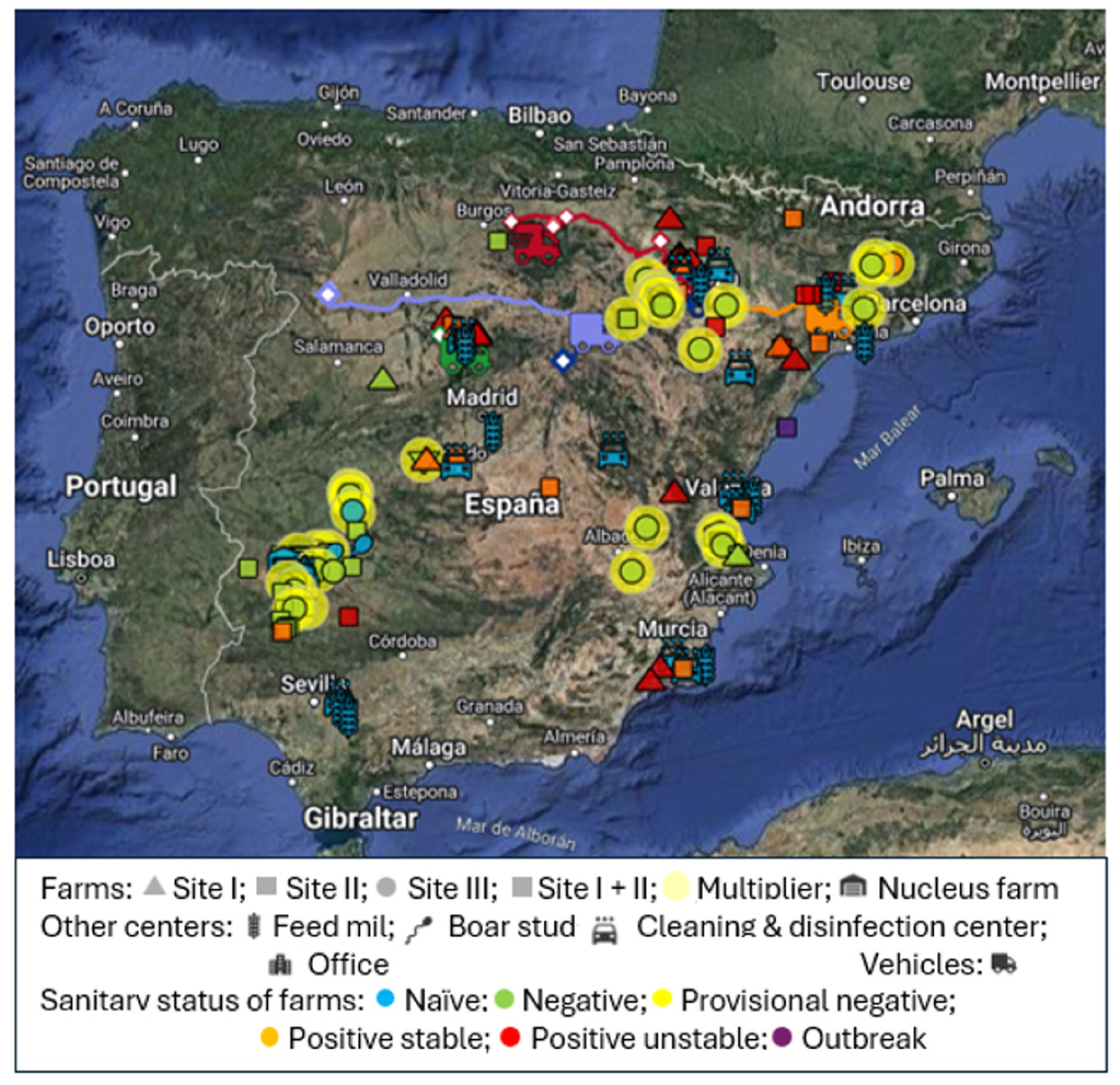
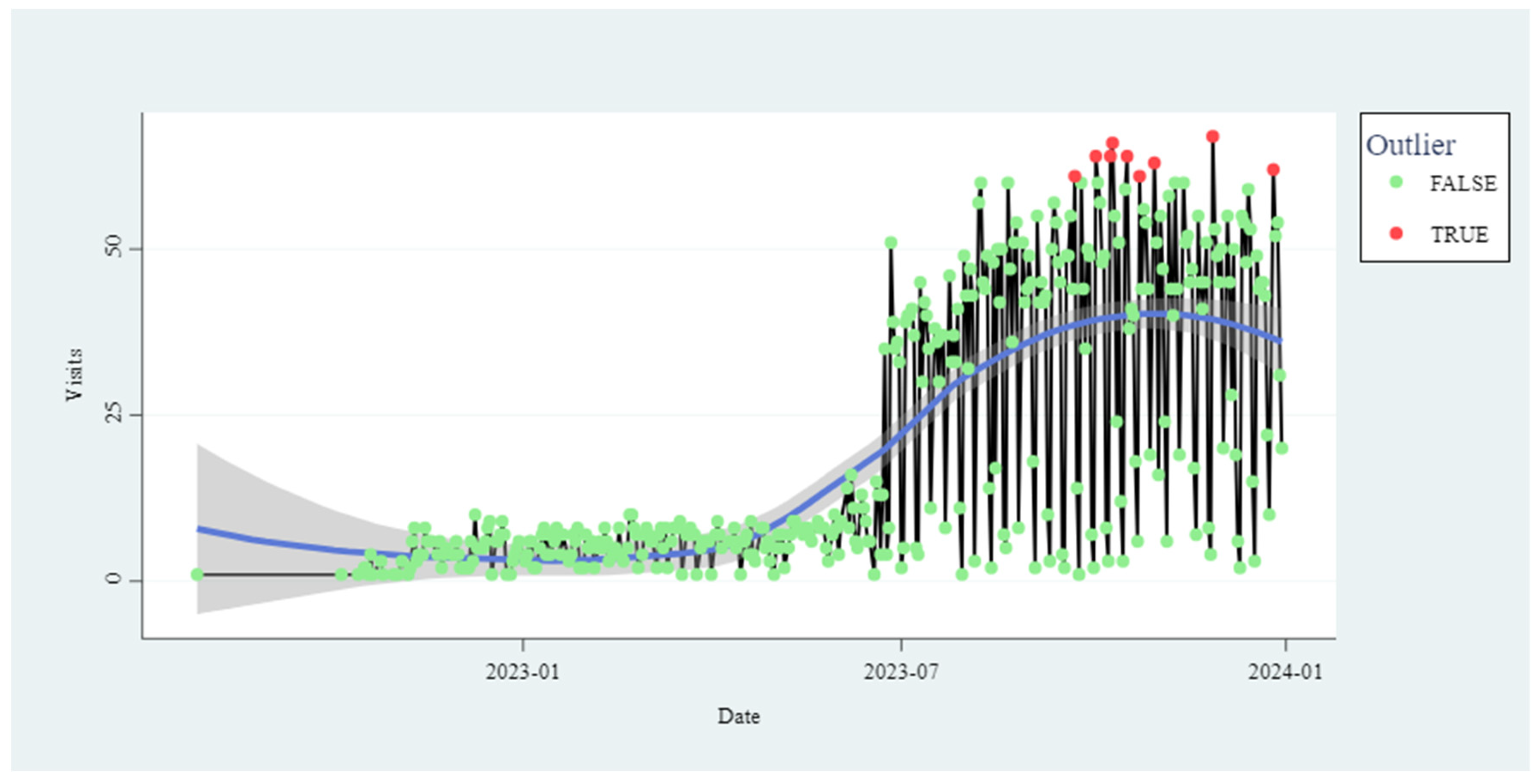
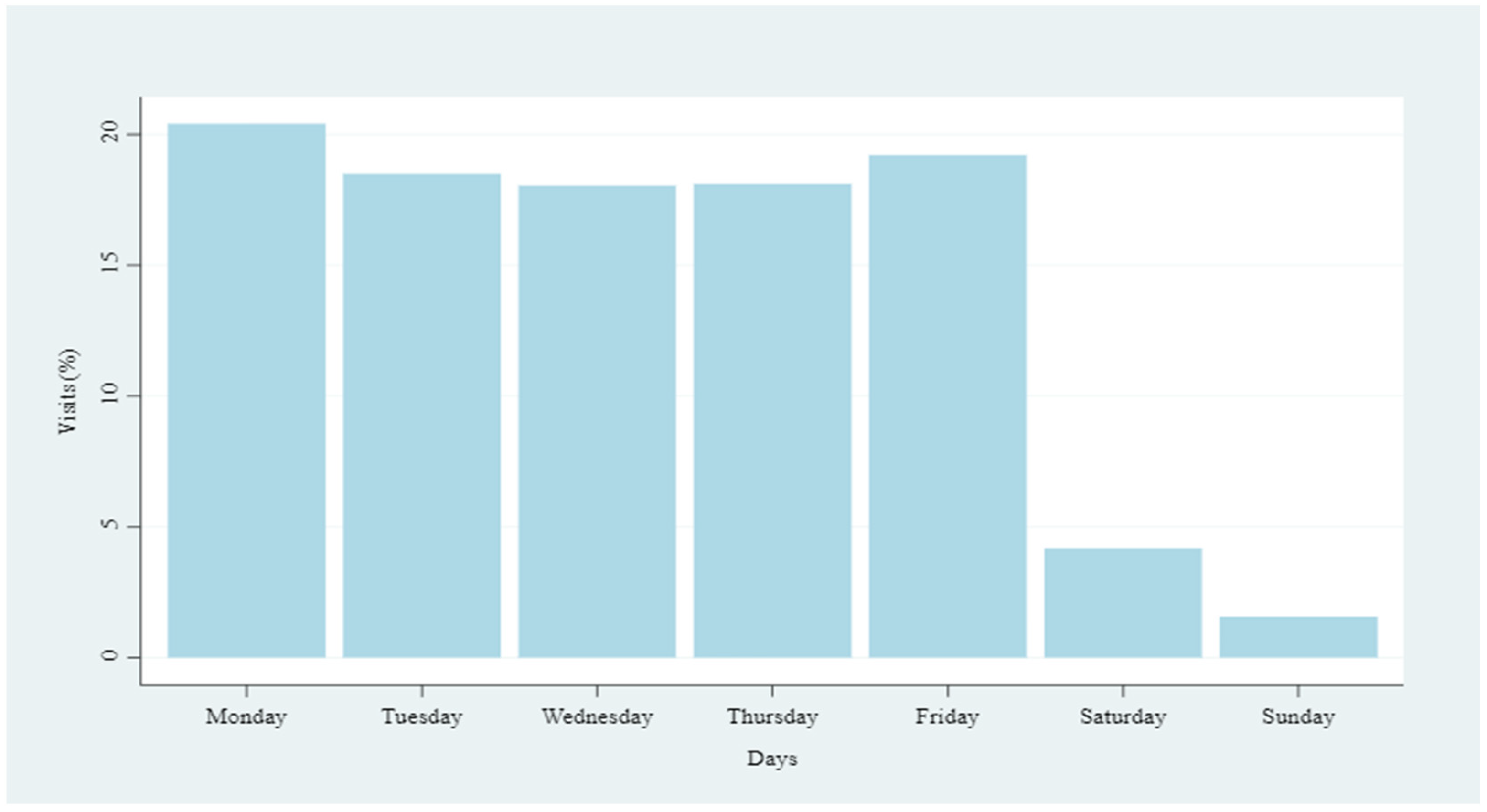
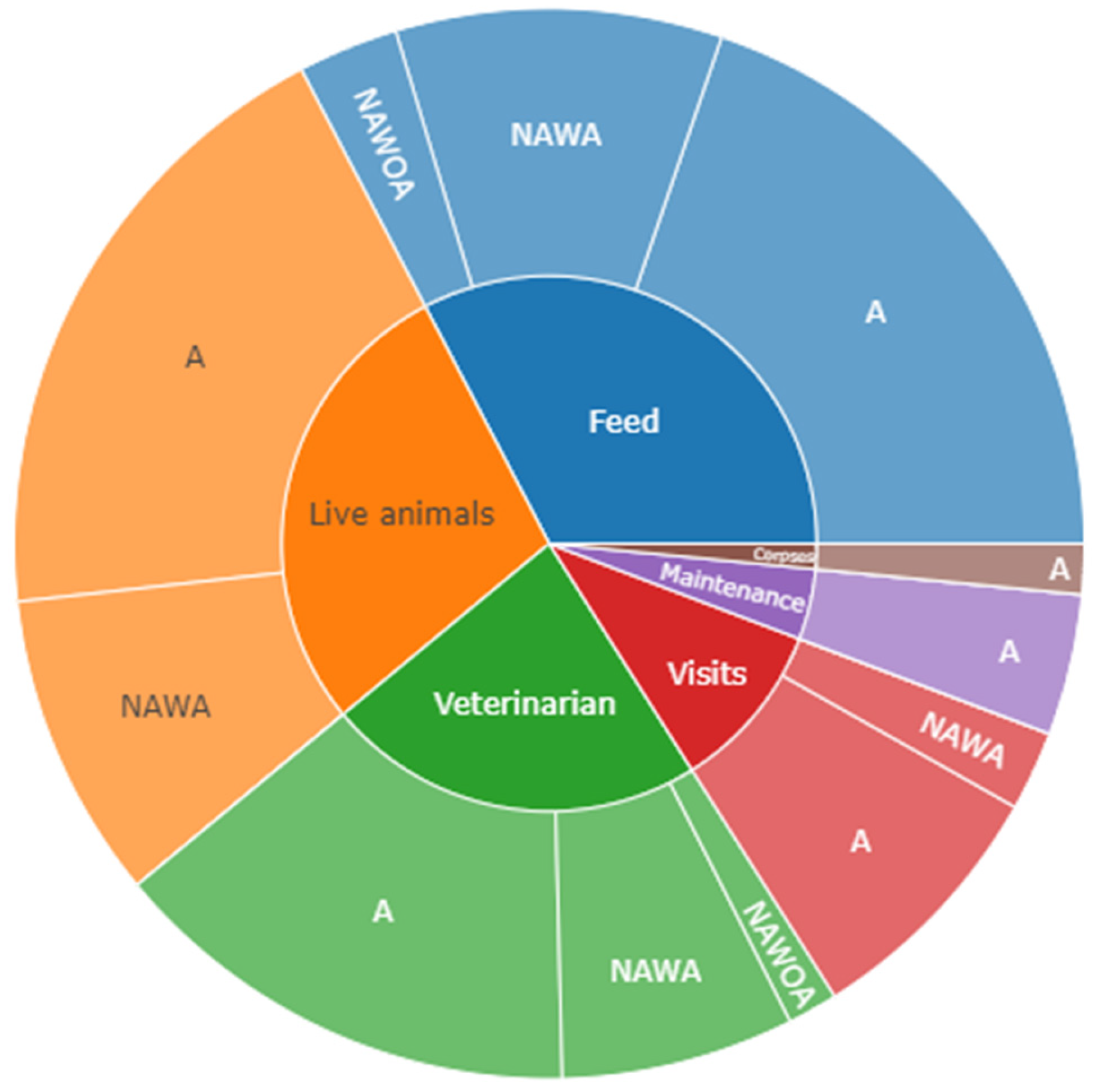
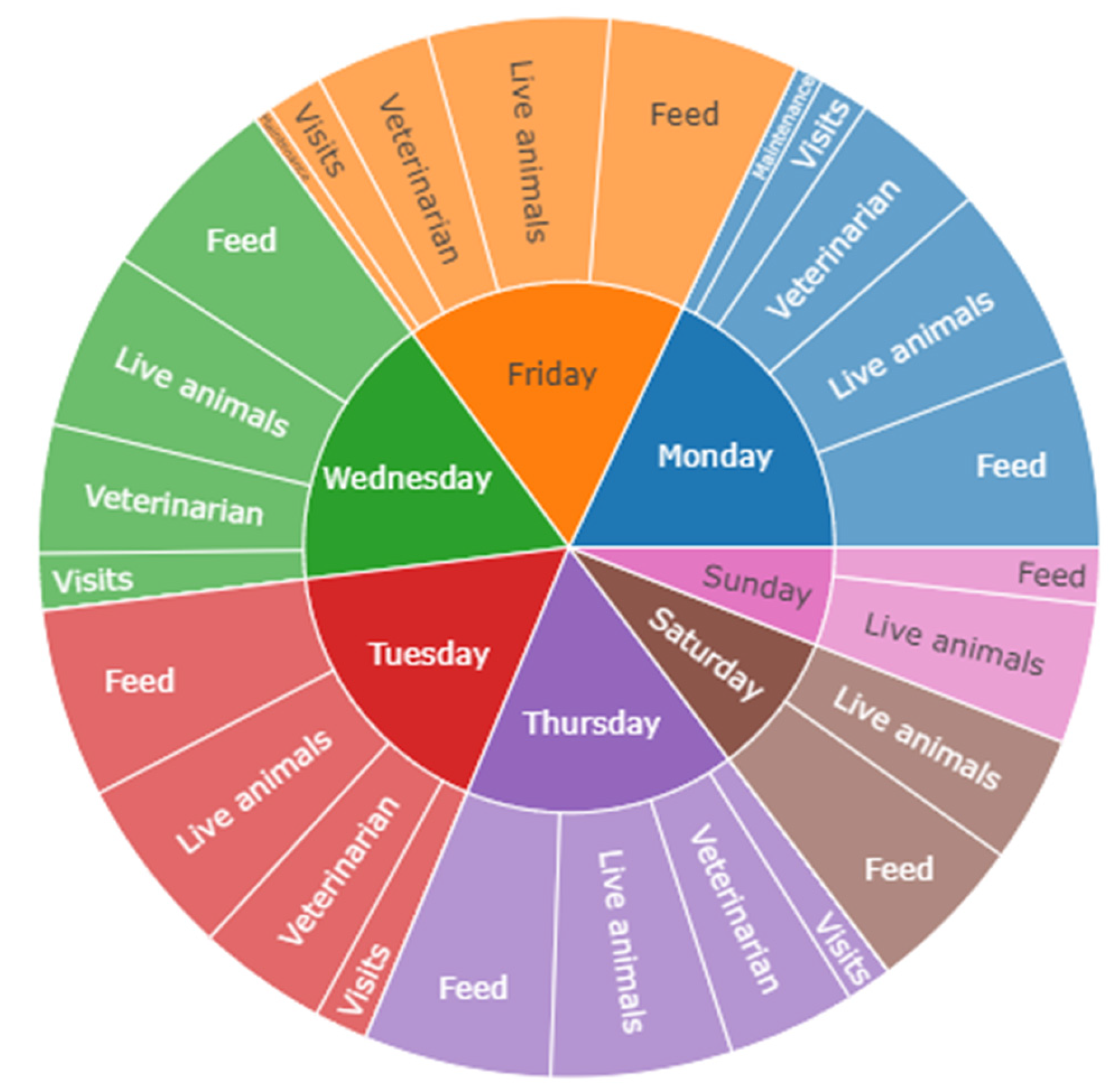
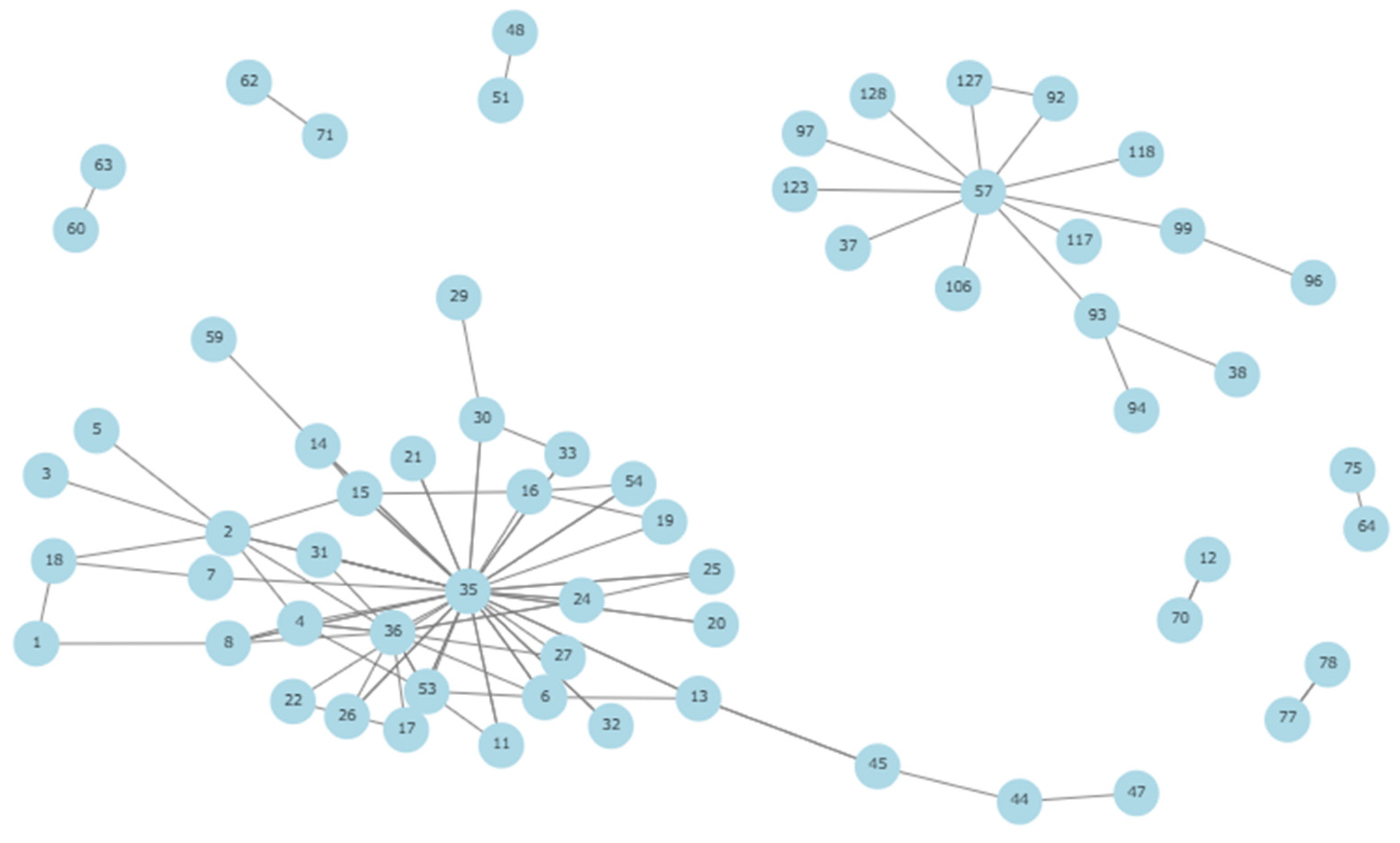
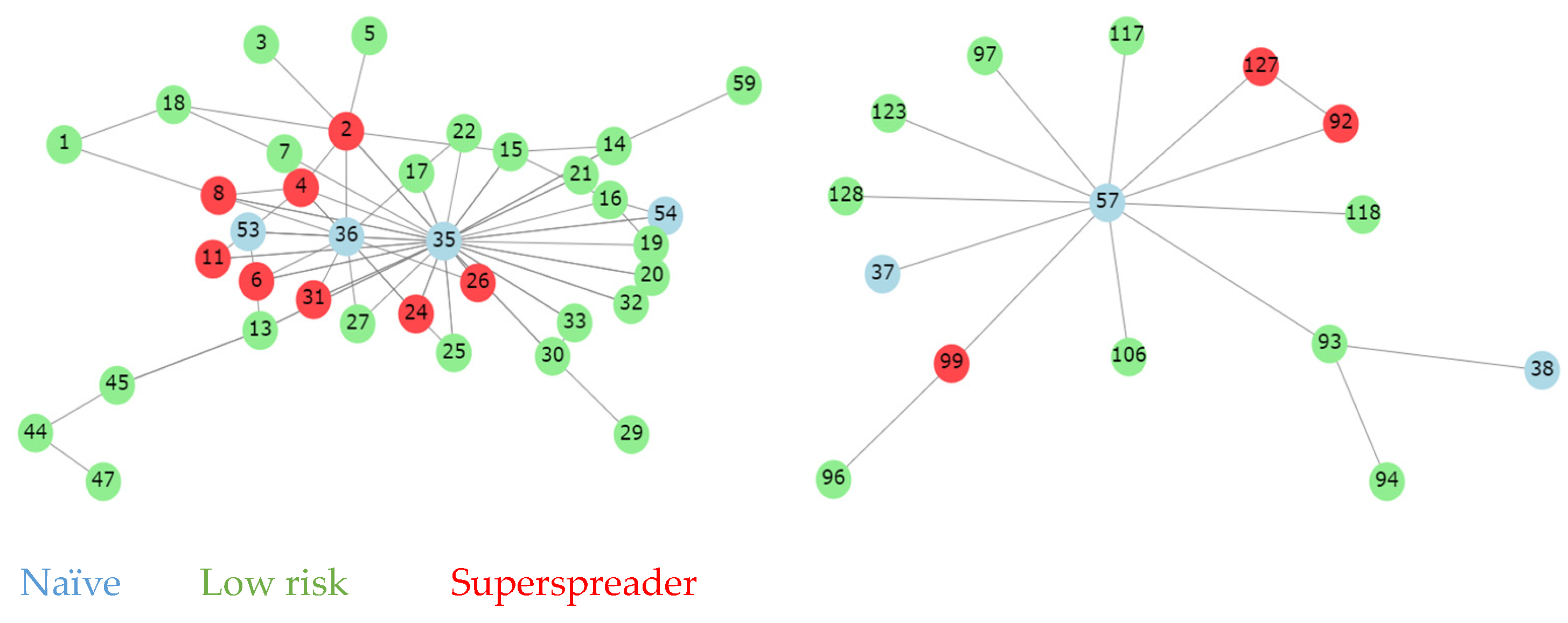
| Category | Number |
|---|---|
| Cleaning and disinfection centers | 14 |
| Feed mills | 10 |
| Sites I | 24 |
| Sites I and II | 63 |
| Sites III | 24 |
| Boar studs | 2 |
| Nucleus farms | 3 |
| Multipliers farms | 2 |
| Vehicles (no categorization) | 30 |
| Date | Number of Visits |
|---|---|
| 22 September 2023 | 61 |
| 02 October 2023 | 64 |
| 09 October 2023 | 64 |
| 10 October 2023 | 66 |
| 17 October 2023 | 64 |
| 23 October 2023 | 61 |
| 30 October 2023 | 63 |
| 27 November 2023 | 67 |
| 26 December 2023 | 62 |
Disclaimer/Publisher’s Note: The statements, opinions and data contained in all publications are solely those of the individual author(s) and contributor(s) and not of MDPI and/or the editor(s). MDPI and/or the editor(s) disclaim responsibility for any injury to people or property resulting from any ideas, methods, instructions or products referred to in the content. |
© 2024 by the authors. Licensee MDPI, Basel, Switzerland. This article is an open access article distributed under the terms and conditions of the Creative Commons Attribution (CC BY) license (https://creativecommons.org/licenses/by/4.0/).
Share and Cite
Soriano, O.; Batista, L.; Morales, J.; Quintana, E.; Piñeiro, C. A Dynamic System to Control the Entry of Non-Authorized Visitors and Detect Superspreader Farms in Strongly Interconnected Systems. Animals 2024, 14, 2932. https://doi.org/10.3390/ani14202932
Soriano O, Batista L, Morales J, Quintana E, Piñeiro C. A Dynamic System to Control the Entry of Non-Authorized Visitors and Detect Superspreader Farms in Strongly Interconnected Systems. Animals. 2024; 14(20):2932. https://doi.org/10.3390/ani14202932
Chicago/Turabian StyleSoriano, Oscar, Laura Batista, Joaquin Morales, Eduardo Quintana, and Carlos Piñeiro. 2024. "A Dynamic System to Control the Entry of Non-Authorized Visitors and Detect Superspreader Farms in Strongly Interconnected Systems" Animals 14, no. 20: 2932. https://doi.org/10.3390/ani14202932
APA StyleSoriano, O., Batista, L., Morales, J., Quintana, E., & Piñeiro, C. (2024). A Dynamic System to Control the Entry of Non-Authorized Visitors and Detect Superspreader Farms in Strongly Interconnected Systems. Animals, 14(20), 2932. https://doi.org/10.3390/ani14202932







